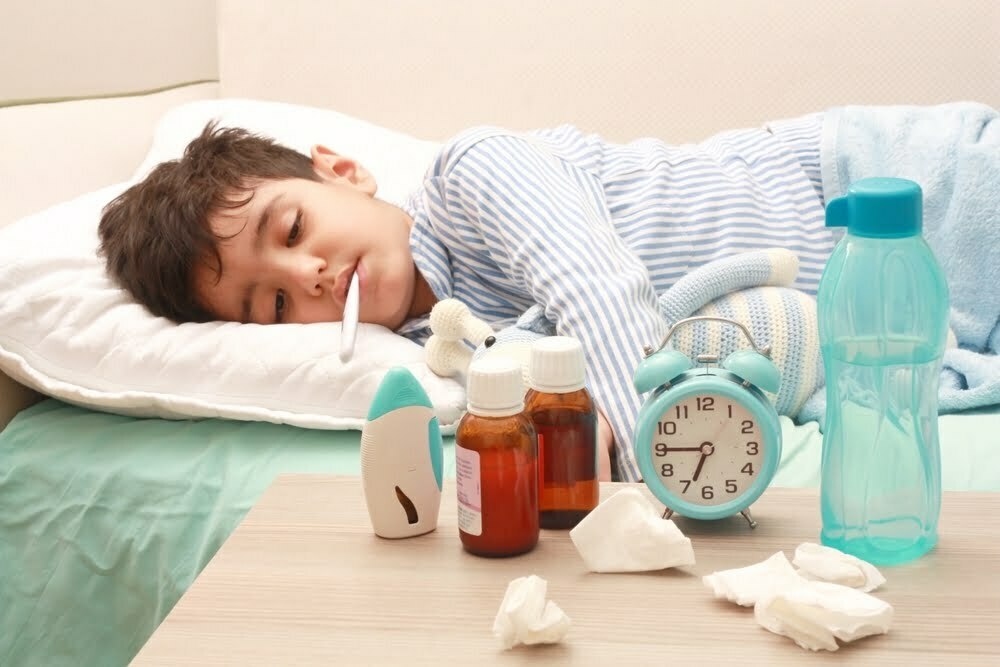
When your child comes down with fever and body aches, it’s natural to worry about serious flu strains like H1N1 (swine flu). While this particular virus is uncommon in the United States, staying informed and attending pediatric sick care appointments is crucial if symptoms arise. The following swine flu information and frequently asked questions should provide everything Cumming parents need to know to keep children safe and healthy.
What is Swine Flu?
Swine Influenza (swine flu) is a respiratory disease of pigs caused by type A influenza virus that regularly causes outbreaks of influenza in pigs. People do not normally get swine flu, but human infections can and do happen. Swine flu viruses have been reported to spread from person-to-person, but in the past, this transmission was limited and not sustained beyond three people. Swine flu viruses cause high levels of illness and low death rates in pigs. Swine influenza viruses may circulate among swine throughout the year, but most outbreaks occur during the late fall and winter months similar to outbreaks in humans. The classical swine flu virus (an influenza type A H1N1 virus) was first isolated from a pig in 1930.
Frequently Asked Questions About Swine Flu
How serious is swine flu infection?
Like seasonal flu, swine flu in humans can vary in severity from mild to severe. Between 2005 until January 2009, 12 human cases of swine flu were detected in the U.S. with no deaths occurring. However, swine flu infection can be serious. In September 1988, a previously healthy 32-year-old pregnant woman in Wisconsin was hospitalized for pneumonia after being infected with swine flu and died 8 days later. A swine flu outbreak in Fort Dix, New Jersey occurred in 1976 that caused more than 200 cases with serious illness in several people and one death.
How many swine flu viruses are there?
Like all influenza viruses, swine flu viruses change constantly. Pigs can be infected by avian influenza and human influenza viruses as well as swine influenza viruses. When influenza viruses from different species infect pigs, the viruses can reassort (i.e. swap genes) and create new viruses that are a mix of swine, human and/or avian influenza viruses can emerge. Over the years, different variations of swine flu viruses have emerged. At this time, there are four main influenza type A virus subtypes that have been isolated in pigs: H1N1, H1N2, H3N2, and H3N1. However, most of the recently isolated influenza viruses from pigs have been H1N1 viruses.
Can humans catch swine flu?
Swine flu viruses do not normally infect humans. However, sporadic human infections with swine flu have occurred. Most commonly, these cases occur in persons with direct exposure to pigs (e.g. children near pigs at a fair or workers in the swine industry). In addition, there have been documented cases of one person spreading swine flu to others. For example, an outbreak of apparent swine flu infection in pigs in Wisconsin in 1988 resulted in multiple human infections, and, although no community outbreak resulted, there was antibody evidence of virus transmission from the patient to health care workers who had close contact with the patient.
Are there documented cases of human infections with swine flu in the U.S.?
In late March and early April 2009, cases of human infection with swine influenza A (H1N1) viruses were first reported in Southern California and near San Antonio, Texas. Other U.S. states have reported cases of swine flu infection in humans and cases have been reportedinternationally as well. An updated case count of confirmed swine flu infections in the United States is kept at http://www.cdc.gov/swineflu/investigation.htm. CDC and local and state health agencies are working together to investigate this situation.
How common is swine flu infection in humans?
In the past, CDC received reports of approximately one human swine influenza virus infection every one to two years in the U.S., but from December 2005 through February 2009, 12 cases of human infection with swine influenza have been reported.
Is this swine flu virus contagious?
CDC has determined that this swine influenza A (H1N1) virus is contagious and is spreading from human to human. However, at this time, it is not known how easily the virus spreads between people.
What are the signs and symptoms of swine flu in people?
The symptoms of swine flu in people are similar to the symptoms of regular human “seasonal influenza” and include fever, cough, sore throat, body aches, headache, chills and fatigue. Some people have reported diarrhea and vomiting associated with swine flu. In the past, severe illness (pneumonia and respiratory failure) and deaths have been reported with swine flu infection in people. Like seasonal flu, swine flu may cause a worsening of underlying chronic medical conditions.
How does swine flu spread?
Spread of this swine influenza A (H1N1) virus is thought to be happening in the same way that seasonal flu spreads. Influenza viruses can be directly transmitted from pigs to people and from people to pigs. Human infection with flu viruses from pigs are most likely to occur when people are in close proximity to infected pigs, such as in pig barns and livestock exhibits housing pigs at fairs. Human-to-human transmission of swine flu can also occur. This is thought to occur in the same way as seasonal flu occurs in people, which is mainly person-to-person transmission through coughing or sneezing of people infected with the influenza virus. Flu viruses are spread mainly from person to person through coughing or sneezing of people with influenza. Sometimes people may become infected by touching something with flu viruses on it and then touching their mouth or nose.
How can someone with the flu infect someone else?
Infected people may be able to infect others beginning 1 day before symptoms develop and up to 7 or more days after becoming sick. That means that you may be able to pass on the flu to someone else before you know you are sick, as well as while you are sick.
Can I get swine influenza from eating or preparing pork?
No. Swine influenza viruses are not spread by food. You cannot get swine influenza from eating pork or pork products. Eating properly handled and cooked pork products is safe.
How can human infections with swine influenza be diagnosed?
To diagnose swine influenza A infection, a respiratory specimen would generally need to be collected within the first 4 to 5 days of illness (when an infected person is most likely to be shedding virus). However, some persons, especially children, may shed virus for 10 days or longer. Identification as a swine flu influenza A virus requires sending the specimen to CDC for laboratory testing.
If I received my seasonal influenza vaccine in the fall, am I protected?
No. The H1N1 swine flu viruses are antigenically very different from human H1N1 viruses and, therefore, vaccines for human seasonal flu would not provide protection from H1N1 swine flu viruses. Vaccines are available to be given to pigs to prevent swine influenza. There is no vaccine to protect humans from swine flu. The current swine flu H3N2 viruses are closely related to human H3N2 viruses. The seasonal influenza vaccine will likely help provide partial protection against swine H3N2, but not swine H1N1 viruses.
Are there medicines to treat swine flu?
Yes. CDC recommends the use of oseltamivir (Tamiflu) or zanamivir for the treatment and/or prevention of infection with these swine influenza viruses. Antiviral drugs are prescription medicines (pills, liquid or an inhaler) that fight against the flu by keeping flu viruses from reproducing in your body. If you get sick, antiviral drugs can make your illness milder and make you feel better faster. They may also prevent serious flu complications. For treatment, antiviral drugs work best if started soon after getting sick (within 2 days of symptoms).
How long can an infected person spread swine flu to others?
People with swine influenza virus infection should be considered potentially contagious as long as they are symptomatic and possible for up to 7 days following illness onset. Children, especially younger children, might potentially be contagious for longer periods. You can follow our tips for preventing common newborn illnesses for guidance on best hygiene practices for your children.
What surfaces are most likely to be sources of contamination?
Germs can be spread when a person touches something that is contaminated with germs and then touches his or her eyes, nose, or mouth. Droplets from a cough or sneeze of an infected person move through the air. Germs can be spread when a person touches respiratory droplets from another person on a surface like a desk and then touches their own eyes, mouth or nose before washing their hands.
How long can viruses live outside the body?
We know that some viruses and bacteria can live 2 hours or longer on surfaces like cafeteria tables, doorknobs, and desks. Frequent handwashing will help you reduce the chance of getting contamination from these common surfaces.
What can I do to protect myself from getting sick?
There is no vaccine available right now to protect against swine flu. There are everyday actions that can help prevent the spread of germs that cause respiratory illnesses like influenza. First and most important: wash your hands. Try to stay in good general health. Get plenty of sleep, be physically active, manage your stress, drink plenty of fluids, and eat nutritious food. Try not touch surfaces that may be contaminated with the flu virus. Avoid close contact with people who are sick.
Take these everyday steps to protect your health:
- Cover your nose and mouth with a tissue when you cough or sneeze. Throw the tissue in the trash after you use it.
- Wash your hands often with soap and water, especially after you cough or sneeze. Alcohol-based hand cleaners are also effective.
- Avoid touching your eyes, nose or mouth. Germs spread this way.
- Try to avoid close contact with sick people.
- If you get sick with influenza, CDC recommends that you stay home from work or school and limit contact with others to keep from infecting them.
What is the best way to keep from spreading the virus through coughing or sneezing?
If you are sick, limit your contact with other people as much as possible. Do not go to work or school if ill. Cover your mouth and nose with a tissue when coughing or sneezing. It may prevent those around you from getting sick. Put your used tissue in the waste basket. Cover your cough or sneeze if you do not have a tissue. Then, clean your hands, and do so every time you cough or sneeze. Your pediatrician can demonstrate how to stay safe and protect your children during well-child checkups for infants and toddlers.
What is the best technique for washing my hands to avoid getting the flu?
Washing your hands often will help protect you from germs. Wash with soap and water. or clean with alcohol-based hand cleaner. We recommend that when you wash your hands- with soap and warm water – that you wash for 15 to 20 seconds. When soap and water are not available, alcohol-based disposable hand wipes or gel sanitizers may be used. You can find them in most supermarkets and drugstores. If using gel, rub your hands until the gel is dry. The gel doesn’t need water to work; the alcohol in it kills the germs on your hands.
Schedule a Sick Care Visit in Cumming, GA
Vickery Pediatrics provides expert sick care services and well-child checkups for children of all ages. We provide exceptional care to children from Cumming, Buford, Dawsonville, Gainesville, Johns Creek, Sugar Hill, Suwanee and Forsyth County. Call (678) 990-2501 or request an appointment today.







